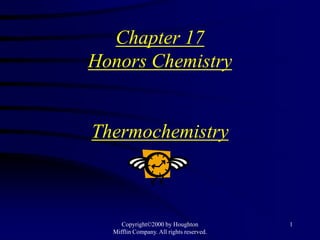
Chapter 17 thermochemistry sections 17.3 & 17.4
- 1. Chapter 17 Honors Chemistry Thermochemistry Copyright©2000 by Houghton 1 Mifflin Company. All rights reserved.
- 2. . Section 17.3 Heat in Changes of State Copyright©2000 by Houghton 2 Mifflin Company. All rights reserved.
- 3. Heats of Fusion and Solidification How does the quantity of heat absorbed by a melting solid compare to the quantity of heat released when the liquid solidifies? Copyright©2000 by Houghton 3 Mifflin Company. All rights reserved.
- 4. The molar heat of fusion (∆Hfus) is the heat absorbed by one mole of a solid substance as it melts to a liquid at a constant temp. Copyright©2000 by Houghton 4 Mifflin Company. All rights reserved.
- 5. The molar heat of solidification (∆Hsolid) is the heat lost when one mole of a liquid solidifies at a constant temperature. Copyright©2000 by Houghton 5 Mifflin Company. All rights reserved.
- 6. That is, ∆Hfus = –∆Hsolid. Copyright©2000 by Houghton 6 Mifflin Company. All rights reserved.
- 8. 17.4
- 9. 17.4
- 10. The amount of heat necessary to vaporize one mole of a given liquid is called its molar heat of vaporization (∆Hvap). Copyright©2000 by Houghton 10 Mifflin Company. All rights reserved.
- 11. The amount of heat released when 1 mol of vapor condenses at the normal boiling point is called its molar heat of condensation (∆Hcond). Copyright©2000 by Houghton 11 Mifflin Company. All rights reserved.
- 12. That is, ∆Hvap = –∆Hcond. Copyright©2000 by Houghton 12 Mifflin Company. All rights reserved.
- 13. 17 Heats of Vaporization and Condensation .3
- 14. –Observe the phase changes as ice is converted to steam when heat is added.
- 15. 17 .3
- 16. 17.5
- 17. 17.5
- 18. Section 17.4 Hess’s Law Reactants Products The change in enthalpy is the same whether the reaction takes place in one step or a series of steps. The change in enthalpy, Δ H, is independent of pathway. Copyright©2000 by Houghton 18 Mifflin Company. All rights reserved.
- 19. Figure 6.7 The Principle of Hess’s Law It does not matter if H for a reaction is calculated in one step or a series of steps. Copyright©2000 by Houghton 19 Mifflin Company. All rights reserved.
- 20. The Principle of Hess’s Law Copyright©2000 by Houghton 20 Mifflin Company. All rights reserved.
- 21. Strategy for using Hess’s Law • Manipulate equations so that they add up to the desired equation. Copyright©2000 by Houghton 21 Mifflin Company. All rights reserved.
- 22. Calculations via Hess’s Law 1. If a reaction is reversed, H is also reversed. N2(g) + O2(g) 2NO(g) H = 180 kJ 2NO(g) N2(g) + O2(g) H = 180 kJ 2. If the coefficients of a reaction are multiplied by an integer, H is multiplied by that same integer. 6NO(g) 3N2(g) + 3O2(g) H = 540 kJ Copyright©2000 by Houghton 22 Mifflin Company. All rights reserved.
- 23. 3. Focus on the reactants and products of the required reaction. Let’s do some Practice Problems Copyright©2000 by Houghton 23 Mifflin Company. All rights reserved.
- 24. Section 17.4 Standard Enthalpies of Formation • Hf • Change in enthalpy that accompanies the formation of one mole of compound from its elements with all substances in their standard states. Copyright©2000 by Houghton 24 Mifflin Company. All rights reserved.
- 25. A degree symbol on a thermodynamic function example H says that the process was carried out under standard conditions. Copyright©2000 by Houghton 25 Mifflin Company. All rights reserved.
- 26. Standard States Compound For a gas, pressure is exactly 1 atmosphere. For a solution, concentration is exactly 1 molar. Pure substance (liquid or solid), it is the pure liquid or solid. Element The form [N2(g), K(s)] in which it exists at 1 atm and 25°C. Copyright©2000 by Houghton 26 Mifflin Company. All rights reserved.
- 27. Change in Enthalpy Important!!!!!-------- Enthalpies of many reactions can be calculated from enthalpies of formation of reactants and products. Hrxn° = np Hf (products) nr Hf (reactants) Copyright©2000 by Houghton 27 Mifflin Company. All rights reserved.
- 28. Hf for an element in its standard state is Zero. Elements in their standard states are not included in the Hrxn calculations. Copyright©2000 by Houghton 28 Mifflin Company. All rights reserved.